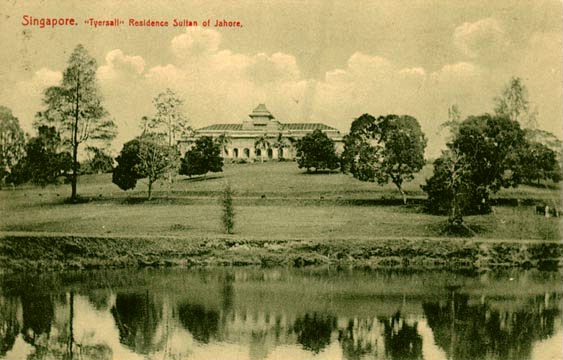|
Tyersall House
Istana Tyersall is a demolished historical palace that used to be in the former Tyersall Park bound by Holland Road and Tyersall Road near the Singapore Botanic Gardens in Singapore. The land it was formerly built on is currently restricted from the public. The demolished palace had long been confused with the dilapidated Istana Woodneuk due to its proximity, which was located on another smaller hill not far away. The difference with the roof tiles of these former palaces is that while Woodneuk was blue, Tyersall was red. History William "Royal Billy" Napier, the former Lieutenant-Governor of Labuan and first lawyer in Singapore, once had a house built in 1854 at the Tyersall estate of 67 acres in Singapore. Upon his retirement and departure back to England in 1857, his house at Tyersall was put on sale by Boustead & Co. in March 1857 and would later be bought over by Wan Abu Bakar in 1860. Abu Bakar would later move his residence there from Telok Blangah upon his reign as ... [...More Info...] [...Related Items...] OR: [Wikipedia] [Google] [Baidu] |
Tyersall Park
Tyersall Park is an estate in Singapore, bound by Holland Road and Tyersall Avenue, and near the Singapore Botanic Gardens. Previously a private land belonging to the Sultan of Johor from 1862, some portions of it had been acquired by the Government of Singapore in 1990 and in 2009 respectively. The property is generally restricted from the public (excluding the parts that have been acquired) and is fenced along Tyersall Avenue. The ring road known as Catterick Circle used to run through the estate, and was still shown on maps even after the late Sultan of Johor's former palaces were no longer charted on any modern maps of Singapore. Catterick Circle was officially removed from updated maps of Singapore in the 1990s. History Early colonial years About three to four decades after Singapore was established as a Straits Settlement trading port in 1819, the adjoined estates consisted of Woodneuk and Tyersall at Tanglin and were first owned by the English trader Captain John Dill ... [...More Info...] [...Related Items...] OR: [Wikipedia] [Google] [Baidu] |
Temenggong Daeng Ibrahim
Raja Temenggong Tun Daeng Ibrahim bin Temenggong Daeng Abdul Rahman (8 December 1810 – 31 January 1862) was the Temenggong of Johor and later the ''de facto'' Maharaja of Johor from 1855 to 1862. Biography Early life Daeng Ibrahim was born in Pulau Bulang, Kepulauan Riau on 8 December 1810 as the second son to Temenggong Abdul Rahman and Inche Yah Moffar. He was also known as Daeng Ronggek, Tengku Chik and Daeng Kechil. A year later in 1811, his family moved to Singapore Island and established a governance there, where they settled near the river (present day Singapore River). In 1823, his father moved the family and their followers to the 200 acres of land (part of Teluk Belanga area) that was assigned by Stamford Raffles, the palace was known as Istana Lama and was later completed in 1824. His father died in the palace on 8 December 1825 and was informally succeeded by his elder brother Tun Haji Abdullah as the ''de facto'' Temenggong of Johor. Reign In 1833, Daeng Ib ... [...More Info...] [...Related Items...] OR: [Wikipedia] [Google] [Baidu] |
Order Of The Double Dragon
The Imperial Order of the Double Dragon () was an order awarded in the late Qing dynasty. The Order was founded by the Guangxu Emperor on 7 February 1882 as an award for outstanding services to the throne and the Qing court. Originally it was awarded only to foreigners but was extended to Chinese subjects from 1908. It was the first Western-style Chinese order, established in the wake of the Second Opium War as part of efforts to engage with the West and adopt Western-style diplomatic practices. Traditionally the Chinese court did not have an honours system in the Western sense; however hat buttons, rank badges, feathers and plumes were routinely awarded by the Emperor to subjects and foreigners alike prior to and after the introduction of the Order of the Double Dragon. The order was replaced in 1911 during the last days of the Qing dynasty by the Order of the Imperial Throne, although this replacement was never fully implemented and the Republic of China discontinued the imper ... [...More Info...] [...Related Items...] OR: [Wikipedia] [Google] [Baidu] |
Abdul Rahman II Muazzam Shah
Abdul (also transliterated as Abdal, Abdel, Abdil, Abdol, Abdool, or Abdoul; ar, عبد ال, ) is the most frequent transliteration of the combination of the Arabic word '' Abd'' (, meaning "Servant") and the definite prefix '' al / el'' (, meaning "the"). It is the initial component of many compound names, names made of two words. For example, , ', usually spelled ''Abdel Hamid'', ''Abdelhamid'', ''Abd El Hamid'' or ''Abdul Hamid'', which means "servant of The Praised" (God). The most common use for ''Abdul'' by far, is as part of a male given name, written in English. When written in English, ''Abdul'' is subject to variable spacing, spelling, and hyphenation. The meaning of ''Abdul'' literally and normally means "Slave of the", but English translations also often translate it to "Servant of the". Spelling variations Variations in spelling are primarily because of the variation in pronunciation. Arabic speakers normally pronounce and transcribe their names of Arabic or ... [...More Info...] [...Related Items...] OR: [Wikipedia] [Google] [Baidu] |

